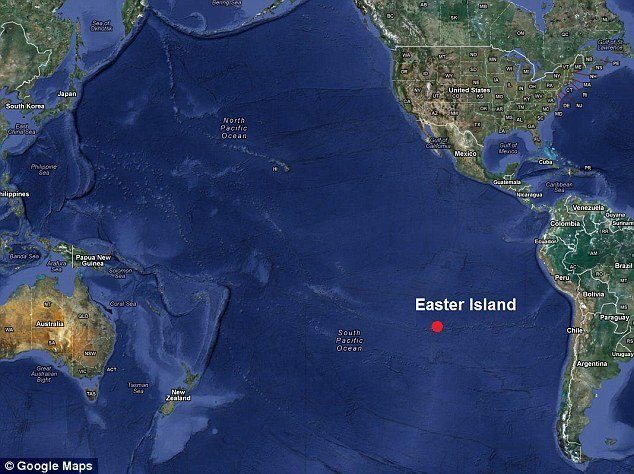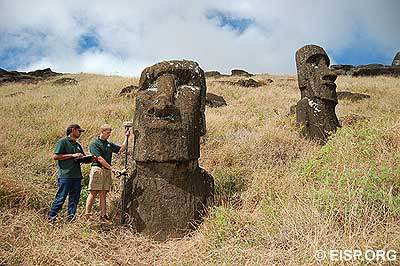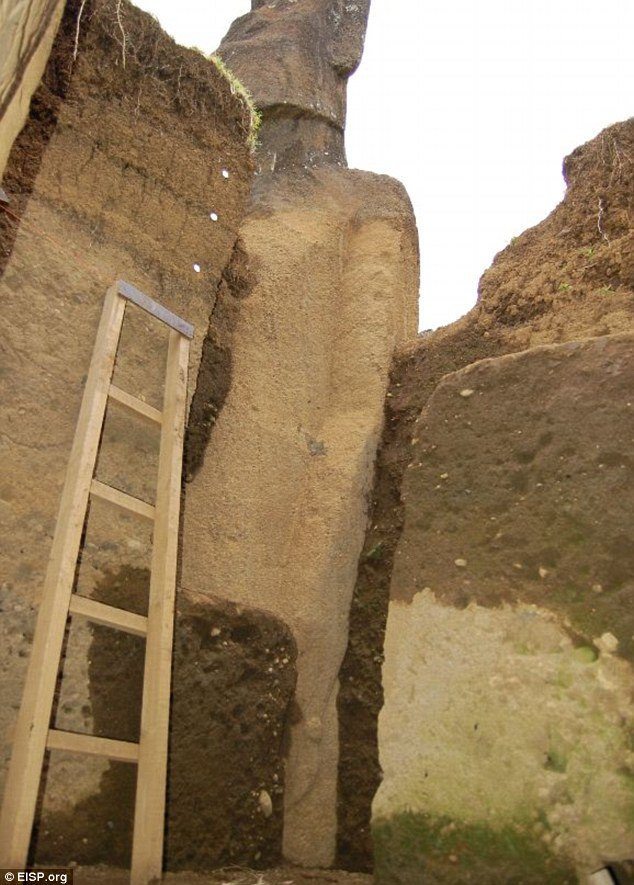 For many years the mysterious statues of Easter Island have been shrouded in secrecy. Over 1000 Easter Island statues litter the tiny island completely devoid of trees and life. These statues have been best known to be giant heads sitting on the surface of the island and defied logic because many of them were so large they would have required thousands of human beings to maneuver the giant statues.
For many years the mysterious statues of Easter Island have been shrouded in secrecy. Over 1000 Easter Island statues litter the tiny island completely devoid of trees and life. These statues have been best known to be giant heads sitting on the surface of the island and defied logic because many of them were so large they would have required thousands of human beings to maneuver the giant statues.
Here is a terrific video by NOVA describing the secrets of the Moai, this vanished civilization on Easter Island:
http://youtu.be/xc8Xio0xWUc
The Easter Island excavation photos shown here are from the Easter Island Statue Project website, www.eisp.org where they have managed to excavate two of those giant statues and discovered that the only part of the statues seen were not just heads sitting haphazardly across the surface of Easter Island, but that the heads had bodies with torsos over 7 m tall. This is an astonishing archeological discovery.
As archeologists excavated these giant statues they found that the tall bodies actually rested on a kind of pavement many feet below the earth’s surface, and many theories of the Eastern Island people were shattered. We were to believe that a primitive people left South America in canoes traveling 2,300 miles off the coast of Chile across the Pacific Ocean to arrive at a tiny island that could be missed easily with an airplane. To find such an island with a boat is an extraordinary feat, but to find it and begin erecting these giant statues for no particular reason defies logic. The revelation that most of these statues have been buried beneath more than 15 feet of soil indicates a truly spectacular geological disaster that would have covered the island with sediment on a scale that was epic. But in so doing, it preserved a lifestyle that might have otherwise been wiped away from the earth forever with natural erosion.

 This archeological discovery is just more proof that much of what we believe we have achieved in human science, has not yet began to scratch the surface. The statues on Easter Island have been available for study for over 100 years, yet it is only now that we have discovered that they have these vast complicated bodies submerged below the ground of the island. The question begs to be answered, if such large statues were ignored for over 100 years under heavy scientific scrutiny, and the terrain was so easily altered upon which the sculpture of the Eastern Island statues existed, then what lost relics exist upon the earth that are completely lost to human eyes and have yet to be discovered?
This archeological discovery is just more proof that much of what we believe we have achieved in human science, has not yet began to scratch the surface. The statues on Easter Island have been available for study for over 100 years, yet it is only now that we have discovered that they have these vast complicated bodies submerged below the ground of the island. The question begs to be answered, if such large statues were ignored for over 100 years under heavy scientific scrutiny, and the terrain was so easily altered upon which the sculpture of the Eastern Island statues existed, then what lost relics exist upon the earth that are completely lost to human eyes and have yet to be discovered?
 As I look at the photos of these statues that I have gazed upon all my life, and I note that what I saw was only a fraction of the overall statue, as most existed under the surface it serves as a metaphor for our infantile science that is only scratching the possibilities of understanding that await mankind. The statues themselves are situated on the triangular-shaped island upon the rim of a volcano of which the island has three, Rano Kau, Maunga Terevaka and Katiki. Easter Island once bestowed lush vegetation and timber, but today that is all but gone. Seeing how the statues are buried now makes me think that one of the three volcanoes erupted violently killing all life on the island including the vegetation. The soil compositions burying the statues so deeply are probably the result of many volcanic eruptions and tsunamis that rushed into the craters of the dead volcanoes and flooded them.
As I look at the photos of these statues that I have gazed upon all my life, and I note that what I saw was only a fraction of the overall statue, as most existed under the surface it serves as a metaphor for our infantile science that is only scratching the possibilities of understanding that await mankind. The statues themselves are situated on the triangular-shaped island upon the rim of a volcano of which the island has three, Rano Kau, Maunga Terevaka and Katiki. Easter Island once bestowed lush vegetation and timber, but today that is all but gone. Seeing how the statues are buried now makes me think that one of the three volcanoes erupted violently killing all life on the island including the vegetation. The soil compositions burying the statues so deeply are probably the result of many volcanic eruptions and tsunamis that rushed into the craters of the dead volcanoes and flooded them.
Now that archeologists have dug to the bottom of these statues to the original plaza of these temples which apparently housed these statues geologists should be able to properly date the Easter Island culture, which I predict will now be several thousand years old instead of the original date somewhere between AD 400 to AD 690. The statues were called moai and range in weight from 20 tons to 90 tons. Some are up to 32 ft tall. The complexity of the statues are odd for such a remote island, but if taken in the context of the nearby Malden Island appear to be a part of a very vast and complicated network of Polynesian societies that were far more advanced than previously thought.
 Once the Eastern Island culture was destroyed centuries of new settlers made the island home, some of which were cannibals, and it would appear that European travelers encountering Easter Island for the first time assumed that it was a version of the cannibals who had built the Easter Island statues. The statues seen in the photographs here are from the quarry at Rano Raraku. It cannot be ignored how these seemingly primitive groups of human beings were so obsessed with moving vast stone works. Such a mystery was difficult to imagine before it was revealed that the statues were much larger than originally thought. Now the prospect is simply mind bending.
Once the Eastern Island culture was destroyed centuries of new settlers made the island home, some of which were cannibals, and it would appear that European travelers encountering Easter Island for the first time assumed that it was a version of the cannibals who had built the Easter Island statues. The statues seen in the photographs here are from the quarry at Rano Raraku. It cannot be ignored how these seemingly primitive groups of human beings were so obsessed with moving vast stone works. Such a mystery was difficult to imagine before it was revealed that the statues were much larger than originally thought. Now the prospect is simply mind bending.
A similar assumption was made at Serpent Mound, Ohio where early archeology quick to report findings for their universities, and thus validate their scientific funding determined that it was the Adena Indians who had built the strange mound structure on the rim of a cryptoexplosion dating 248 million to 286 million years ago. Cryptoexplosions are extremely rare on planet earth and are debated to be caused by meteor impacts or volcanic forces from under the earth’s crust. The builders of Serpent Mound appeared to understand in a primitive time where no society could have known what happened more than 200 million years ago, that the ground upon which mound was built was very unique. More archeological research has been conducted over the last couple of decades and Serpent Mound appears to be much older than originally thought, well into the thousands of years ago. The Adena Indians simply did as apparently the cannibals of Easter Island did, they settled the area long after the original builders had left or been destroyed and were given credit for being the descendents of the original culture.
http://www.youtube.com/watch?v=RYx-C_IVd28
There is a yearning to display the learned power and command over natural resources that just is not evident in primitive, collective societies at the Easter Island archeological site at Rano Raraku. The ability to find a tiny island in the middle of the Pacific Ocean and build these tremendous standing statues is the work of more than nomads or hunters and gatherers. The recent discoveries at Easter Island is further proof that we are simply on page one in understanding the vast history of the human race that has been hidden by education monopolies, religious insistence, and human impatience to quickly smash the world’s facts into the meat grinder of domestic understanding. Ultimately the answer was always right in front of us, as it usually is. But it took someone to actually do some digging to get “to the bottom of it” so to speak, and discover that there is much more to the story than we ever thought, or conceived.
Article by Rich Hoffman from his page www.OvermanWarrior.com

